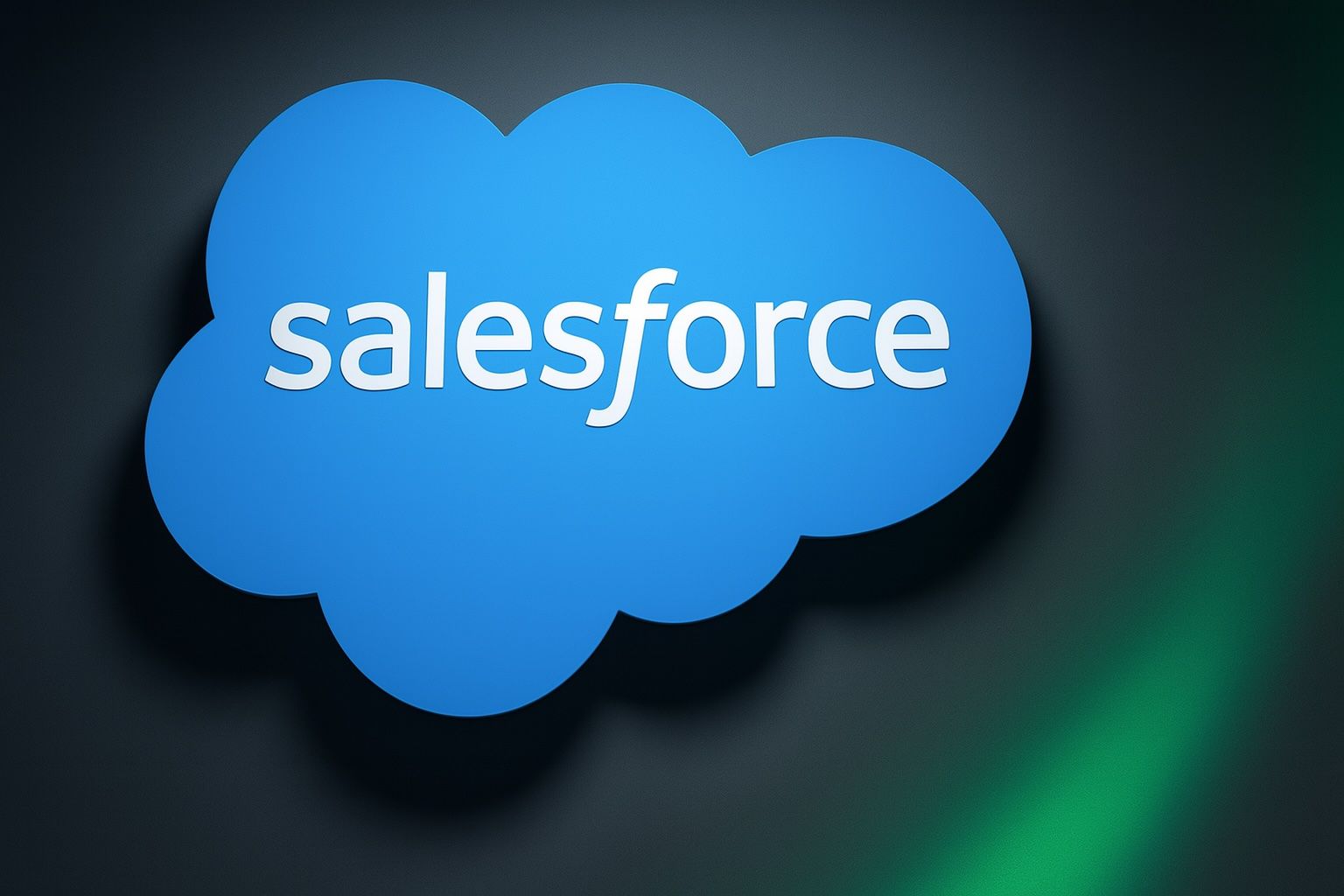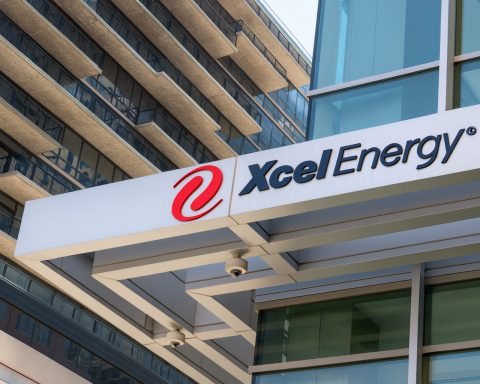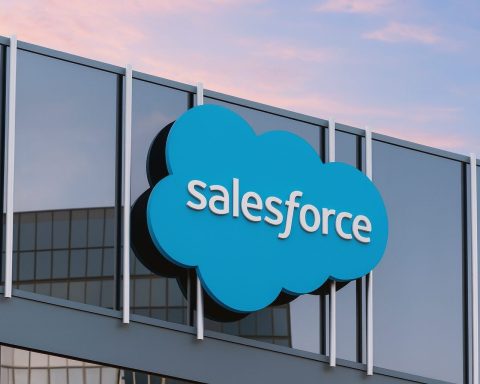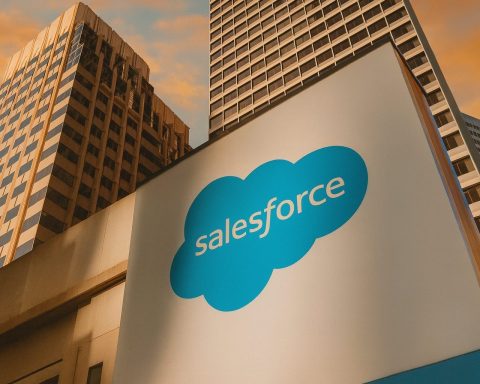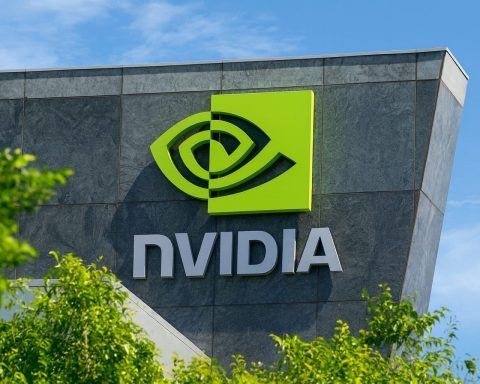- Solid FY26 results amid AI pivot. Salesforce’s fiscal Q2 2026 revenue grew 10% year‑over‑year to $10.2 billion, with subscription and support revenue up 11% to $9.7 billion and current remaining performance obligations rising 11% to $29.4 billion. GAAP operating margin climbed to 22.8% and non‑GAAP margin to 34.3%. CEO Marc Benioff called it an “outstanding quarter” and highlighted an anticipated $15 billion in operating cash flow for FY26.
- Soft guidance triggered market volatility. Salesforce’s FY26 Q3 revenue guidance of $10.24–$10.29 billion missed analyst expectations and sparked an 8% sell‑off after the Sept. 3 earnings release [1]. Analysts worry about the pace of AI monetization and the timeline for returns on heavy investments [2].
- Stock at multi‑year lows but inexpensive relative to peers. CRM shares closed at $235.69 on Oct. 1 2025, down ~29% year‑to‑date and 13.9% over the past 12 months [3] [4]. Despite the drop, Salesforce’s forward P/E (19.7) is lower than Microsoft and Oracle’s 31–32× [5] and the company trades at 3.67× book value [6].
- Aggressive M&A to build an “agentic” AI platform. Salesforce has made several acquisitions to assemble a unified data and AI foundation. Major deals in 2025 include the $8 billion purchase of Informatica for data management [7], the AI‑native workflow company Regrello [8], the UK AI assistant startup Convergence.ai [9], and data protection provider Own Company for $1.9 billion [10]. The company announced a $20 billion increase in its share‑repurchase plan and an additional $6 billion investment to make the UK its AI hub [11].
- Strategic shifts and controversies. Salesforce is pivoting its climate commitments from absolute emission cuts to intensity‑based targets, arguing this approach better accommodates growth and energy‑hungry AI workloads [12]. The company replaced its help‑page search bar with its AI assistant Agentforce, prompting user backlash over slower responses and raising questions about forced AI adoption [13].
Latest News (late September–October 1 2025)
Earnings and Guidance
Salesforce reported fiscal Q2 2026 results on Sept. 3. Revenue grew 10% year‑over‑year to $10.2 billion, with subscription and support revenue contributing $9.7 billion (up 11%). Current remaining performance obligations increased to $29.4 billion, while GAAP operating margin reached 22.8% and non‑GAAP margin 34.3%. Shareholder returns totalled $2.6 billion through dividends and buybacks; the board authorised an additional $20 billion share‑repurchase program. CEO Marc Benioff celebrated the “outstanding quarter” and said the company is on track for record operating cash flow of about $15 billion. President and CFO Robin Washington said Salesforce exceeded all financial targets and achieved its tenth consecutive quarter of margin expansion.
However, the company’s Q3 FY26 revenue guidance of $10.24–$10.29 billion represented growth of 8–9%, below Wall Street expectations. Salesforce raised the low end of its full‑year revenue outlook to $41.1–$41.3 billion (8.5–9% growth) and lifted its non‑GAAP operating margin forecast to 34.1%, while forecasting operating cash‑flow growth of about 12–13%.
Market Reaction and Analyst Responses
Investors punished Salesforce for the soft guidance. Shares fell over 5% on Sept. 3 and nearly 8% the next day as analysts questioned whether the company’s aggressive investments in AI would translate into near‑term revenue. S&P Global Visible Alpha’s Melissa Otto noted that investors “may be frustrated about the timeline for returns on AI investments,” while Valoir CEO Rebecca Wettemann warned that recent acquisitions could invite activist scrutiny [14]. Hargreaves Lansdown analyst Matt Britzman remarked that the guidance gave “bears fresh ammo,” whereas Oppenheimer analysts called the growth outlook “uninspiring” [15]. J.P. Morgan analysts saw opportunity in the sell‑off, arguing that the stock’s low valuation relative to peers created room for upside [16].
Strategic Announcements and Deals
Salesforce continues to reshape itself around “agentic” AI. On Sept. 16 it pledged to invest $6 billion in the UK by 2030 to establish it as the company’s primary AI hub [17]. This builds on a previous $4 billion commitment and aligns with the company’s plan to integrate AI agents into every part of its Customer 360 platform. The UK technology minister welcomed the investment, and Salesforce said acquisitions like Convergence and Own Company would be integrated into this hub [18] [19].
Salesforce announced a definitive agreement on Aug. 18 to acquire Regrello, an AI‑native workflow automation platform, using cash on hand. Regrello’s technology will integrate with Agentforce and Slack to convert complex business processes into agile, agentic workflows [20]. Earlier in the year, Salesforce agreed to buy AI startup Convergence.ai, whose digital assistants will enhance Agentforce’s capabilities [21]. The May announcement of an $8 billion acquisition of data‑management leader Informatica signaled Salesforce’s ambition to build the industry’s most complete agent‑ready data platform [22]. In September 2024, Salesforce also agreed to acquire Own Company for $1.9 billion to bolster data protection [23].
Industry Partnerships and Product Updates
In September Salesforce announced that data‑as‑a‑service provider Statista would adopt Agentforce to transform its sales and service operations. The AI agent will automate classification of email and chat inquiries, reducing processing time by up to 40%, and deliver context‑based response suggestions that can speed ticket resolution by up to 50% [24]. Statista’s SVP Henning Helbig said AI is central to the company’s revenue‑operations strategy [25].
Salesforce is also pushing deeper into vertical industries. In August more than 70 pharmaceutical and medtech organizations adopted its Life Sciences Cloud to integrate sales, service, marketing and clinical data across a unified AI platform. The solution aims to accelerate clinical trials and provide personalized health‑care experiences, with executives from Centricity Research and Protas praising the ability to streamline recruitment and patient engagement [26] [27].
Controversies and Corporate Responsibility
Salesforce’s aggressive AI push has generated controversy. The company replaced the search bar on its help pages with the Agentforce AI assistant, sparking user complaints that the assistant was slower and less reliable. Industry experts Tom Bassett and Sarah Orens urged Salesforce to reinstate the traditional search function, arguing that forced AI adoption compromises user experience [28]. Additionally, the company shifted its 2030 emission‑reduction goal from an absolute target to an intensity‑based metric—emissions per unit of profit—arguing this better reflects growth and energy‑intensive AI workloads. Critics say the change could allow absolute emissions to rise and undermines the company’s climate leadership [29].
Stock Performance
Price Movement
Salesforce’s stock closed at $235.69 on Oct. 1 2025 [30]. Over the previous month, CRM shares slid about 7% (from $253.07 on Sept. 2 to $235.69) amid disappointment with Q3 guidance [31]. The stock’s one‑week change ending Oct. 1 showed relative stability as it oscillated between $237 and $235.69 [32]. Year‑to‑date, shares have fallen roughly 29%, reflecting investor worries about AI monetization and integration costs; Macrotrends notes that 2025’s average price of $275.10 compares to an opening price of $329.05 and a closing price of $235.69 [33].
Valuation and Ratios
With a market capitalization of about $224 billion, Salesforce remains one of the largest enterprise software firms [34]. The company’s trailing P/E ratio was around 34.3, while its forward P/E was a more modest 19.7, reflecting expectations of earnings acceleration as AI investments begin to pay off [35]. Other valuation metrics include a price‑to‑sales ratio of 5.71, price‑to‑book of 3.67 and price‑to–free‑cash‑flow of 17.95 [36]. Salesforce’s beta of 1.22 indicates higher volatility than the S&P 500 but suggests potential outperformance when markets rebound [37].
Peer Comparison
The stock’s depressed valuation is notable relative to software peers. Reuters noted that Salesforce trades at roughly 20× forward earnings, compared with Microsoft and Oracle at 31–32× [38]. Despite weaker near‑term growth, J.P. Morgan analysts argued that this discount leaves room for multiple expansion if AI products gain traction [39].
Expert Commentary
- Management’s optimism: CEO Marc Benioff emphasised that Salesforce is building a “limitless agentic workforce” where humans and AI agents work together across the Customer 360, Data Cloud and Einstein platforms. CFO Robin Washington highlighted the tenth consecutive quarter of operating margin expansion and the company’s commitment to shareholder returns.
- Analyst caution: Melissa Otto of S&P Global Visible Alpha noted that investors may be frustrated by the timeline for AI returns [40]. Matt Britzman of Hargreaves Lansdown said the outlook gave “bears fresh ammo,” while Oppenheimer called it uninspiring [41]. Rebecca Wettemann cautioned that new acquisitions could invite activist investor scrutiny [42]. Conversely, J.P. Morgan analysts see room for growth given the low valuation [43].
Forecasts and Analysis
Revenue and Earnings Outlook
Salesforce guided Q3 FY26 revenue of $10.24–$10.29 billion, implying 8–9% year‑over‑year growth, and raised full‑year revenue guidance to $41.1–$41.3 billion (8.5–9% growth). The company also lifted its non‑GAAP operating margin forecast to 34.1%, GAAP margin to 21.2%, and projected operating cash‑flow growth of 12–13%. With Data Cloud and AI annualized recurring revenue exceeding $1.2 billion and growing 120% year‑over‑year, analysts expect AI to become a larger revenue contributor by FY27.
Price Targets and Sentiment
Published price targets vary widely. Some bullish analysts foresee the stock rebounding towards the high‑$300s over the next 12–18 months if AI products take off, given CRM’s historical peak near $370 [44]. Bearish commentators warn that competition from Microsoft’s Dynamics, Oracle’s Fusion suite, and niche AI‑native players could limit upside. Most expect mid‑single‑digit revenue growth through FY26, with margins supported by disciplined cost control. Investors should monitor adoption of Agentforce, integration of acquisitions and clarity on monetization of AI services.
Competitive Landscape
Salesforce dominates the customer relationship management (CRM) market but faces intense competition from established and emerging players:
- Microsoft Dynamics 365: A cloud suite integrating CRM and enterprise resource planning (ERP) with deep integration into Office and Azure. Microsoft trades at a higher forward P/E and leverages its broad customer base and large AI investments to cross‑sell Dynamics and OpenAI‑powered features.
- Oracle Fusion/NetSuite: Oracle provides a unified ERP/CRM cloud with strong database and financials capabilities. Its forward P/E is around 32×, reflecting steady growth and a broad enterprise installed base [45].
- Adobe: Through Experience Cloud, Adobe competes in digital marketing and customer analytics. While smaller in CRM, it differentiates through content creation and marketing automation.
- Specialised AI SaaS startups: Companies such as Monday.com, HubSpot and Freshworks are embedding AI features into lightweight CRM systems. They focus on small‑ and mid‑market customers, potentially constraining Salesforce’s expansion in those segments.
- Data & analytics rivals: Snowflake and Databricks offer modern data platforms that compete with Salesforce’s Data Cloud and recently acquired Informatica. These firms emphasise open architectures and may lure customers seeking vendor neutrality.
Salesforce’s response is to build an integrated platform where customer data, AI agents and workflow automation converge. The acquisitions of Informatica, Regrello, Convergence and Own Company are designed to provide proprietary data management, security and AI capabilities, positioning Salesforce as the end‑to‑end provider for “agentic enterprises.”
Strategic Context
Salesforce’s vision is to evolve from a CRM provider into a platform for “agentic” enterprises—organizations where AI agents and human employees collaborate. The company’s core products include:
- Customer 360 & Data Cloud: Centralizes customer data across sales, service, marketing and commerce, enabling unified profiles and AI insights. The acquisition of Informatica aims to strengthen data governance and master data management [46].
- Agentforce & Einstein: AI assistants that handle tasks such as support inquiries, content generation and workflow automation. The purchase of Convergence.ai adds digital‑assistant technology [47], while the Regrello acquisition brings process‑automation capabilities [48].
- Slack, Tableau & MuleSoft: Collaboration, analytics and integration tools acquired earlier; they underpin real‑time decision making and data visualization.
- Vertical Solutions: Industry clouds for health, life sciences, financial services, public sector and manufacturing. The Life Sciences Cloud adoption by 70+ organizations underscores traction in regulated industries [49].
Salesforce’s M&A strategy is to assemble a unified data and AI stack to differentiate from rivals. The $8 billion Informatica deal and smaller acquisitions like Regrello and Convergence illustrate a willingness to spend heavily to secure technology and talent. Management has also broadened capital returns through a $20 billion share‑repurchase authorization and raised dividends. At the same time, the company is investing $6 billion to develop an AI hub in the UK, demonstrating its commitment to global R&D expansion [50].
However, Salesforce must navigate cultural and operational challenges. Its shift from absolute emission reductions to intensity‑based goals has drawn criticism from sustainability advocates who argue it weakens climate ambition [51]. The company’s decision to remove the search bar in favour of Agentforce on help pages illustrates the tension between innovation and user satisfaction [52]. Activist investors could push for governance or strategic changes, especially if acquisitions underperform or margins compress.
Conclusion
As of Oct. 1 2025, Salesforce stands at a crossroads. The company delivered solid FY26 results and continues to expand margins, but investors remain sceptical about near‑term revenue growth and the payoff from its ambitious AI strategy. The stock trades at a discount to peers, suggesting significant upside if AI adoption accelerates and acquisitions are integrated effectively. Yet the path to building a comprehensive agentic platform is complex, involving heavy investment, cultural shifts and intense competition. Stakeholders should watch forthcoming events such as Salesforce’s investor day on Oct. 15 and monitor adoption metrics for Agentforce and Data Cloud, progress on integrating acquisitions and clarity around the company’s updated climate commitments.
Sources
- Salesforce Investor Relations: Q2 FY26 results and guidance.
- Reuters articles on revenue forecast and market reactions [53] [54].
- Macrotrends stock price data [55] [56].
- StockAnalysis statistics and ratios [57] [58].
- Salesforce press releases on acquisitions and investments [59] [60] [61] [62] [63] [64].
- Salesforce customer case studies and industry cloud announcements [65] [66].
- Trellis analysis of climate target shift [67].
- CX Today article on Agentforce and user backlash [68].
References
1. www.reuters.com, 2. www.reuters.com, 3. www.macrotrends.net, 4. stockanalysis.com, 5. www.reuters.com, 6. stockanalysis.com, 7. investor.salesforce.com, 8. www.salesforce.com, 9. www.goodwinlaw.com, 10. www.reuters.com, 11. www.salesforce.com, 12. trellis.net, 13. www.cxtoday.com, 14. www.reuters.com, 15. www.reuters.com, 16. www.reuters.com, 17. www.salesforce.com, 18. www.salesforce.com, 19. www.salesforce.com, 20. www.salesforce.com, 21. www.goodwinlaw.com, 22. investor.salesforce.com, 23. www.reuters.com, 24. www.salesforce.com, 25. www.salesforce.com, 26. www.salesforce.com, 27. www.salesforce.com, 28. www.cxtoday.com, 29. trellis.net, 30. www.macrotrends.net, 31. stockanalysis.com, 32. stockanalysis.com, 33. www.macrotrends.net, 34. stockanalysis.com, 35. stockanalysis.com, 36. stockanalysis.com, 37. stockanalysis.com, 38. www.reuters.com, 39. www.reuters.com, 40. www.reuters.com, 41. www.reuters.com, 42. www.reuters.com, 43. www.reuters.com, 44. www.macrotrends.net, 45. www.reuters.com, 46. investor.salesforce.com, 47. www.goodwinlaw.com, 48. www.salesforce.com, 49. www.salesforce.com, 50. www.salesforce.com, 51. trellis.net, 52. www.cxtoday.com, 53. www.reuters.com, 54. www.reuters.com, 55. www.macrotrends.net, 56. www.macrotrends.net, 57. stockanalysis.com, 58. stockanalysis.com, 59. www.salesforce.com, 60. www.salesforce.com, 61. www.goodwinlaw.com, 62. www.salesforce.com, 63. www.reuters.com, 64. investor.salesforce.com, 65. www.salesforce.com, 66. www.salesforce.com, 67. trellis.net, 68. www.cxtoday.com
